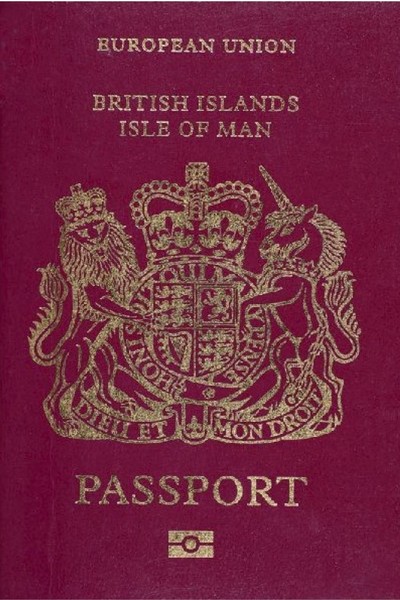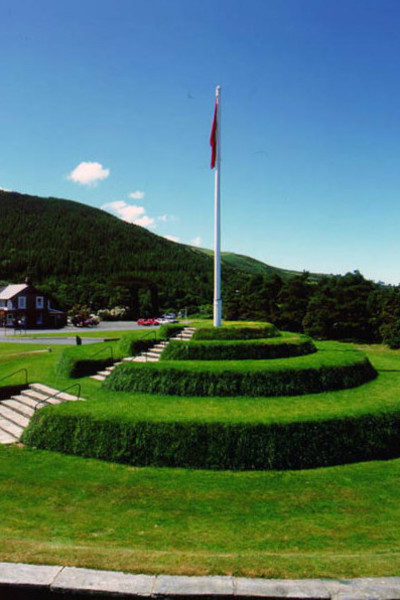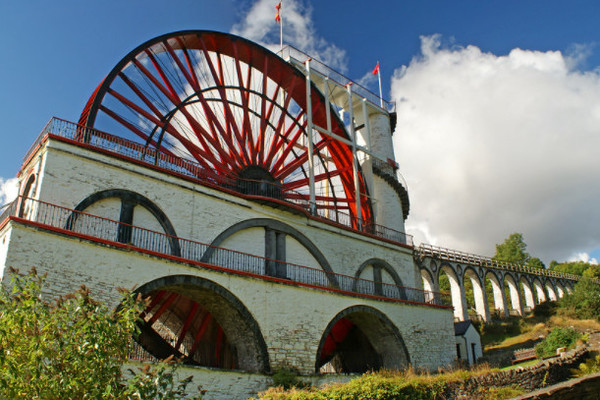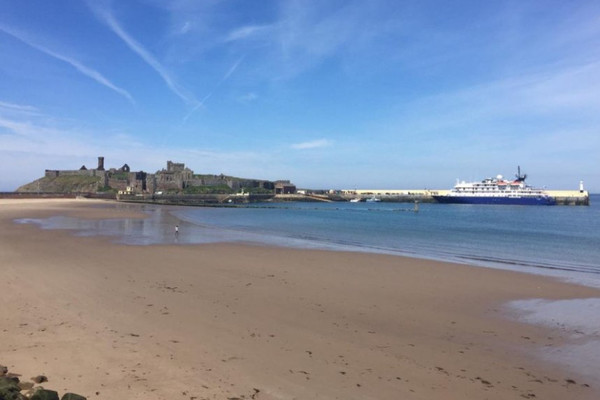A thousand years of history on our doorstep
By Mike Deegan, Head of Fleet Operations
I have written previously in these pages of a career rich in the diversity of places visited. I have also noted that some places closer to home are less well known to us and worth exploring, especially in the comfort afforded to us aboard a Noble Caledonia cruise.
One of those places is the mystical Isle of Man located slap bang (technical term!) in the middle of the Irish Sea but a place many people have yet to set foot on. Let me take you on a whistle stop tour not only of some if it’s many places of interest but also of it’s incredible history and we shall touch on a couple of legends along the way.
Firstly let’s consider it’s unique political status : not (and never has been) a part of the EU but is included within the “common purse agreement” of the UK (which means we provide defence of the island but it is a self-governing Crown Dependency), the Isle of Man is represented at international forums by the UK but its own Government (of which more later) is responsible for all domestic matters including taxation. Under British law the island is not part of the UK but it’s citizens are classified as British citizens - their passports however are over-stamped with the legend “BRITISH ISLANDS – ISLE OF MAN”.

The name itself is interesting : it is said to be derived from Manannan who in Irish mythology was the King of the Otherworld. Ships arriving at Douglas Harbour usually rise and fall to the swells and eddies created around Douglas Head adjacent – it is said they are bowing in respect to Manannan as they arrive!
There is no evidence that the Romans ever landed on the island but they certainly knew about it naming it Insula Manavia. The first known invaders were the Vikings and they conquered and occupied the island from the end of the 8th Century. The Viking heritage on the island is still evident and the annual Peel Viking Festival is testament to this. During the festival various re-enactments are staged but the dramatic culmination comes when a torch-light procession ends with a replica longboat being set ablaze in the harbour. The House of Manannan in Peel (we often berth our ships in the harbour at Peel – most larger ships anchor off the capital Douglas on the opposite side of the island) is well worth a visit – it is housed in a building that was the Peel terminus of the steam railway and it houses many Viking artefacts.
The Vikings established the island’s first Parliament which they named Tynwald. Some say that Tynwald, which survives to this day, was established in 979AD which makes it the oldest continually sitting legislative assembly in the world. The Viking Parliament originally met at Tynwald Hill in the village of St Johns near to Peel on the east coast of the island. The site is the location of an annual ceremony on Tynwald Day (July 5) in which the laws of the Isle of Man are distributed in both Manx Gaelic and English.

These days Tynwald meets in Douglas and comprises two houses : the House of Keys is the executive branch of the Government and is made up of directly elected representatives called Members of the House of Keys or MHKs. It is headed by a Chief Minister. The Legislative Council, consisting of ex-officio members most of whom are appointed by the Crown, forms the upper chamber of “The Court of Tynwald”. The Queen is represented on the island by a Lieutenant Governor (currently Sir Richard Gozney – he is the 30th incumbent). Interestingly Tynwald was the first in the world to give women the right to vote (in 1881) although bizarrely not married women!
Until 1266 the island was governed by Norway but that year King Magnus VI of Norway gifted the island to Scotland under the Treaty of Perth. Between then and 1346 sovereignty alternated between Scotland and England and many battles were fought over it including a five week siege of Castle Rushen in Castletown in 1314. Both Castletown, which was the capital of the island until 1869, and Castle Rushen, a beautifully restored medieval castle by the peaceful harbour, construction of which is thought to have started in the 10th century and where the last King of Mann died in 1265, are well worth a visit.
Topography of the island is diverse. To the north rolling mountains include the island’s highest peak Snaefell (2036 ft). An electric tramway runs from the picturesque town of Laxey on the east coast to the summit in the Summer. As a diversion on our way to the Summit allow me to suggest a visit to Laxey : the seafront is idyllic on a Summer’s day - I can heartily recommend the tea shop there and a visit to the Lady Isabella waterwheel, built in 1854 to pump water out of the Laxey mines but still turning and, at 72 feet in diameter, the world’s largest working waterwheel, is a must. For those interested in such matters it revolves at 3 revolutions a minute.

Anyway I digress: we were on our way to the summit of Snaefell. From the top on a clear day observers can see 7 Kingdoms. When I was at sea myself I used to bet a Chunky KitKat (other chocolate bars are available!) to passengers that they couldn’t name all 7 Kingdoms. To date I have not had to fork out but if you ever sail with me your barred from taking part now. Before I reveal the Kingdoms – have a go yourself then scroll down (by the way the most outrageous suggestion I ever got was Gibraltar! That has got to be some eye sight!!)……no peeking till you’ve had a stab……..
I said no peeking
Stumped? Well the 7 Kingdoms are : England; Wales; Scotland; Ulster; Eire…below you the Kingdom of Mann and above you the Kingdom of Heaven.
The coastal town and small port of Ramsey to the north of Laxey boasts palm trees on the sea front! I am sure Alan Hardwick or one of our other talented Botanists would correct me and tell me they are actually Cabbage Plants but they look for all the world like palm trees!
Further south dramatic cliffs abound which bring their own birdlife and other wildlife with them. The Calf of Man, a small islet to the south of the main island, is a bird sanctuary and bird observatory where there is a breeding colony of Manx Shearwater. It is also home to a large colony of seals. We often undertake Zodiac cruising of Calf Sound, the narrow strip of water which separates the Calf and it’s nearby islets Chicken Rock and Kinterland from the island.
Up above the Sound is Creigneash which is a living museum dedicated to the preservation of the traditional Manx way of life. You can also see examples of the Loughran sheep there, unique to the island with it’s four or six horns.
We alternate our calls between alongside berths at the capital Douglas and the quieter west coast harbour of Peel. Both boast one of the largest tidal ranges in the world – upwards of 30 feet! Peel is where the Manx Kipper industry is based : our Hotel Managers always find a stock of Manx Kippers on our visits and I urge you to try one – you will never eat another type! As a fresh-faced youth (before the ice age) I sailed on ships to and from Douglas and brought a pair of Manx Kippers home for my mother to cook me for breakfast on each occasion I came home. On one famous occasion I forgot and left them in my bag such was my excitement to be home. By then time I came to get the bag out of the back of the wardrobe to return to sea, the Kippers had evolved into an intelligent life form and answered to the name of Eric. I had to beat them to death with a stick!
The breakwater where we berth at Peel (a berth denied ships any larger than our ships) is actually on St Patrick’s Isle and is connected to the mainland by a causeway. St Patrick’s Isle has the ruins of the 11th century castle (originally built by the Vikings) and the later St German’s cathedral (the barrelled vault is still intact – incredible) on it – you can see the ruins in Expedition Leader Pam Le Noury’s excellent photo of Hebridean Sky at Peel below.

The castle is the sight of one of the island’s most famous legends – that of the Moddey Dhoo or ghostly dog. Soldiers at the castle are said to have been terrified of venturing into a particular part of the castle on the long night watches in case they encountered the Moddey Dhoo! Eventually the corridor leading to that part of the castle was bricked up. Soldiers who encountered the apparition were said to die a grizzly death not long after giving rise to modern speculation that the Moddey Dhoo was actually a rabid dog that had wandered off one of the many sailing ships moored in the harbour close by!
Talking of legends – don’t be tempted to cross the Fairy Bridge just south of Douglas on the road to Castletown without saying hello to the fairies said to live underneath it or you will have bad luck. A favourite uncle many years ago tried his luck and bellowed “WHAT A LOAD OF RUBBISH” as his car crossed the bridge. His appendix burst the next morning – you have been warned!
Finally, as with many of my writings on this site, I can’t leave the Isle of Man without mentioning matters maritime and one of its most famous institutions. The Isle of Man Steam Packet Company is the oldest continually trading passenger shipping company in the world. It’s ferries still plough a reliable furrow from the island to the “other side” (islanders never refer to the mainland – it is always “the other side”) but the first crossing was made in June 1830 by the Paddle Steamer Mona’s Isle. Ever since, including through both world wars, their ships have been the mainstay of links to the UK, even after air travel became more universally acceptable. Samuel Cunard, whose office overlooked the Steam Packet’s berth at Liverpool, is said to have liked the Steam Packet livery so much (black hull, white upperworks, corn-coloured masts and orange-red funnel with black top and banding) that he copied it for his Cunard fleet. The Steam Packet has served the nation well over the years with its ships and seafarers serving with distinction in both world wars. In the First World War the company provided 11 ships to the Admiralty, four of which were lost. In November 1918 the company’s SS King Orry was the sole representative of the Merchant Navy at surrender of the German Navy at Scapa Flow. In the Second World War, the company had ten ships requisitioned for war service, four of which were lost. Two of those ships were lost during the 1940 evacuation from Dunkirk (including the same SS King Orry as at Scapa Flow) and in 2010 the anchor from one of those ships, SS Mona’s Queen, was salvaged from the near wreck (it had become detached during the sinking so did not form part of the War Grave) and was later displayed as a permanent memorial at Port St Mary on the island where many of the crew came from. The company has tended to use the same ship names many times over for it’s ships such as Monas Isle, Monas Queen, Ben-My-Chree, Mona, Lady of Mann etc. This gives rise to the old Liverpool joke (to be uttered in broad scouse) “Who painted the Mona Lisa?” “It must have been Cammell Lairds – they did most of the Isle of Man boats”. When I sailed in their ships in the 1970s and 80s the seamen wore blue woolly pullies with the 3 legs of man emblem surrounded by the company initials : IOMSPCoLtd. It was obvious what the letters stood for but in a Winter south easterly gale we joked it stood for “I Often Make Sick People Comfortable Or Let Them Die!”
So that’s our brief tour of the island concluded and I haven’t even scratched the surface of the millennium of history, of the amazing flora and fauna and of the unique heritage that exists on our very doorstep. I urge you to join us on a cruise to this most fascinating of islands sometime soon – but don’t forget : you can’t take part in my Chunky Kitkat challenge now!





